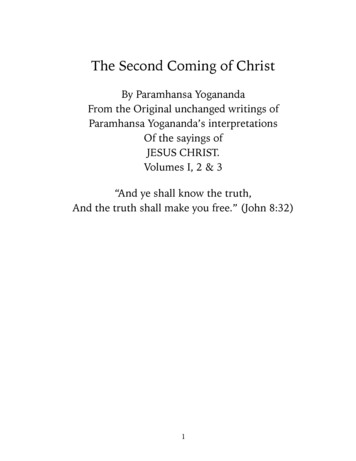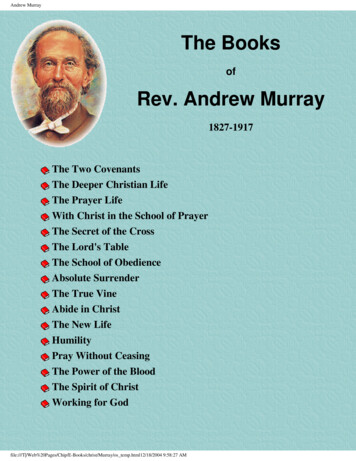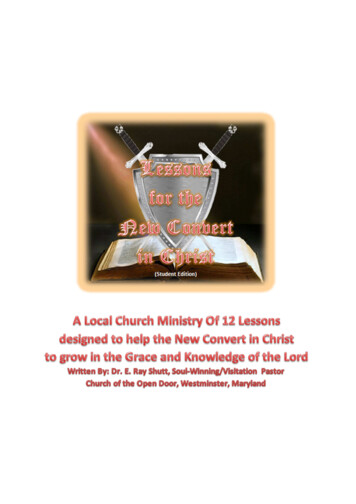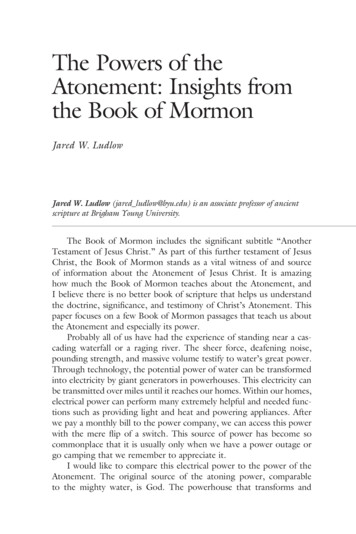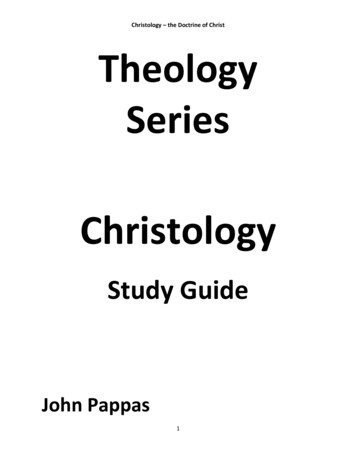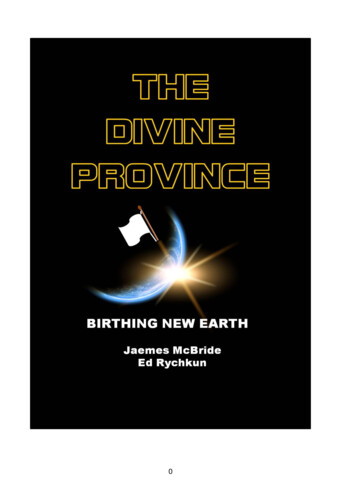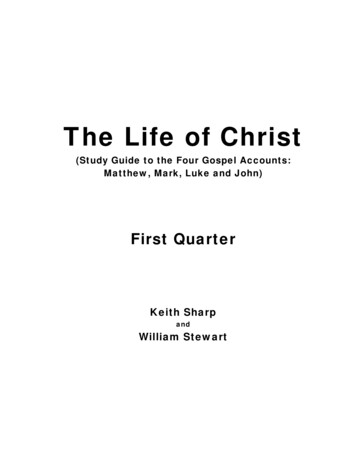
Transcription
The Life of Christ(Study Guide to the Four Gospel Accounts:Matthew, Mark, Luke and John)First QuarterKeith SharpandWilliam Stewart
The Life of Christ(Study Guide to the Four Gospel Accounts: Matthew, Mark, Luke and John)To the TeacherThe Life of Christ (Study Guide to the Four Gospel Accounts: Matthew, Mark,Luke and John) is a Bible study guide for teenagers and adults to be used in Bible classes inlocal congregations. This workbook is not intended to replace the word of God as the classtext. Nor is it a commentary. Rather, it consists of questions within the framework of ananalytical outline designed to help the student study properly, so he can discover for himselfwhat the Bible teaches.My experience is that adult and teenage classes generally do not like graded lessons.Thus, this book has no grading system.However, these same classes have a tendency to “bog down” or stray from the lessonunless some time goals are established and followed. Thus, this study guide is designed tolead the student through the life of Jesus Christ in fifty-two lessons.Beginning with lesson two, each lesson starts with a memory verse. I believecommitting the word of God to memory is an important, often neglected aspect of the lives ofChristians.The workbook contains several types of questions: terms to define, places to locate,people to identify, fact questions, thought questions, reports to the class, charts and maps tofill in, as well as reviews. Each question has a purpose. There are no pointless, filler questions,trick questions or true-false questions.Although a particular word may appear many times in the four accounts of the life ofJesus, it will be given as a term to define only once, unless it is later translated from a differentGreek word, used in a different sense, or has a special importance in a later context. The sameprinciple is true of places to locate and people to identify. These questions are designed tohelp the student understand the language of the text and place the events in their historicaland geographical settings.There is a glossary in the back of the book which defines the terms and identifies thepeople.There are maps in the back of the book with blank maps beneath each to be filled infrom the map above. The student should find each place to locate on the appropriate map andwrite in its name in the proper place on the blank map below. To the right of each place tolocate is the name of the map on which it is found.
ForewordFact questions are for the purpose of checking the student’s knowledge of what heread.Thought questions are designed to measure the student’s understanding of and abilityto apply the text.Each class should end with a review orally in class of the theme of each sectionstudied to that point. Beginning with lesson two, each class should start with the oral reviewfound at the first of each lesson. In this way the students will be able to remember the generalframework of the life of Christ and where each event is found in the Bible. The facts to revieware located together between lesson thirteen and the maps.Because the lessons call for a fast overview of the life of the Lord, it is crucial thateach student study his lesson and complete the questions outside class. It is best in class toconcentrate on the thought questions and to only spend time on other questions with whichsome student might have trouble.In addition to reading the entire biblical text to be studied in each lesson, the studentshould read each passage again separately as he comes to it in the analytical outline. Finally,in order to answer the fact and thought questions, every student must read the passage thatanswers each question. If the student will follow the suggested steps in the lesson, he willread each verse of the lesson three times: beginning with the longest for overall grasp, thenshorter reading for outline, and finally shortest reading for analysis.The questions are based on the New King James Version of the Bible. It minimizesconfusion over the text when the teacher and all the students study from the same translation.No work book can even begin to replace a competent teacher, with a good workingknowledge of the Scriptures, an unswerving love of and loyalty to truth, a deep faith in Godand His word, a pure life, an humble opinion of himself, an understanding of and love for hisstudents, and the ability to communicate.I hope and pray this volume is useful to you in learning more about the life of ourLord Jesus Christ. May it deepen your faith in Him, help you to understand His will, equipyou to defend the faith and teach it to others, and help prepare you to serve Him who leftheaven to serve His Father and us. The Authorii
The Life of ChristThe Life of Christ(Study Guide to the Four Gospel Accounts: Matthew, Mark, Luke and John)Course PlanWe will study the life of Christ in fifty two lessons.Lesson One: Introduction to the Four Gospel AccountsLesson Two: Introduction to Christ (Matthew 1:1-17; Luke 1:1-25; 3:23-38; John 1:1-18)Lesson Three: Births of John and Jesus (Matthew 1:18-25; Luke 1:26 - 2:7)Lesson Four: Jesus’ Childhood (Matthew 2:1-23; Luke 2:8-52)Lesson Five: Beginnings of the Ministries of John and Jesus (Matthew 3:1 - 4:11; Mark 1:1-13; Luke 3:122; 4:1-13)Lesson Six: John’s First Testimony and Jesus’ Early Work (John 1:19 - 3:21)Lesson Seven: John’s Further Testimony and Jesus’ Further Work (Matthew 4:12,17; Mark 1:14-15; Luke3:19-20; 4:14-15; John 3:22 - 4:54)Lesson Eight: Jesus in Galilee (Matthew 4:13-16,18-25; 8:2-4,14-17; Mark 1:16-45; Luke 4:31-44; 5:1-16)Lesson Nine: Jesus in Galilee and Judea (Matthew 9:2-9; Mark 2:1-14; Luke 5:17-28; John 5:1-47)Lesson Ten: Jesus in Judea and Galilee (Matthew 10:2-4; 12:1-21; Mark 2:23 - 3:19; Luke 6:1-16)Lesson Eleven: The Sermon on the Mount: Part 1 (Matthew 5:1-48; Luke 6:17-30,32-36)Lesson Twelve: The Sermon on the Mount: Part 2 (Matthew 6:1-34)Lesson Thirteen: The Sermon on the Mount: Part 3 (Matthew 7:1-29; Luke 6:37-49)Lesson Fourteen: Healing and Teaching in Galilee (Matthew 8:1,5-13; 11:2-30; Luke 7:1-35)Lesson Fifteen: Teaching in Galilee (Matthew 12:22-45; Mark 3:20-30; Luke 7:36-50; 8:1-3; 11:14-36)Lesson Sixteen: Further Teaching in Galilee (Matthew 12:46-50; Mark 3:31-35; Luke 8:19-21; 11:37 13:9)Lesson Seventeen: Introduction to Parables (Matthew 13:1-23; Mark 4:1-20; Luke 8:4-15)Lesson Eighteen: The First Great Group of Parables (Matthew 13:24-53; Mark 4:21-34; Luke 8:16-18)Lesson Nineteen: Galilean Ministry (Matthew 8:18-34; 9:1,10-13; Mark 2:15-17; 4:35 - 5:21; Luke 5:2932; 8:22-40)Lesson Twenty: Teaching and Healing in Galilee (Matthew 9:14-34; Mark 2:18-22; 5:22-43; Luke 5:33-39;8:41-56)Lesson Twenty One: From Nazareth to All Israel (Matthew 13:54-58; 9:35 - 10:1; 10:5 - 11:1; Mark 6:113; Luke 4:16 - 31; 9:1-6)Lesson Twenty Two: John’s Death and Jesus’ Retirement (Matthew 14:1-21; Mark 6:14-44; Luke 9:7-17;John 6:1-14)Lesson Twenty Three: From Popularity to Rejection (Matthew 14:22-36; Mark 6:45-56; John 6:15 - 7:1)Lesson Twenty Four: Teaching and Healing in Galilee (Matthew 15:1-28; Mark 7:1-30; John 7:1)Lesson Twenty Five: More Teaching and Healing (Matthew 15:29 - 16:20; Mark 7:31 - 8:30; Luke 9:1821)Lesson Twenty Six: Preparing the Disciples (Matthew 16:21 - 17:27; Mark 8:31 - 9:32; Luke 9:22-45)Lesson Twenty Seven: Capernaum to Jerusalem (Matthew 18:1-35; Mark 9:33-50; Luke 9:46-62; John 7:210)Lesson Twenty Eight: Jesus at the Feast of Tabernacles in Jerusalem (John 7:11 - 8:59)Lesson Twenty Nine: Teaching in Judea (Luke 10:1-24; John 9:1 - 10:21)Lesson Thirty: Jesus in Judea (Luke 10:25 - 11:13; 13:10-30; John 10:22-42)Lesson Thirty One: Teaching in Perea (Luke 13:31 - 15:32)Lesson Thirty Two: Great Lessons and a Great Miracle (Luke 16:1 - 17:10; John 11:1-46)iii
ForewordLesson Thirty Three: Jesus Retires from and Returns to Judea (Matthew 19:1-2; Mark 10:1; Luke 17:11 18:14; John 11:47-54)Lesson Thirty Four: Lessons in Judea (Matthew 19:3-30; Mark 10:2-31; Luke 18:15-30)Lesson Thirty Five: Teaching and Healing on the Way to Jerusalem (Matthew 20:1-34; Mark 10:32-52;Luke 18:31 - 19:10)Lesson Thirty Six: Completing the Journey to Jerusalem (Matthew 21:1-11,14-17; 26:6-13; Mark 11:1-11;14:3-9; Luke 19:11-44; John 11:55 - 12:19)Lesson Thirty Seven: Beginning the Last Week in Jerusalem (Matthew 21:12-13,18-32; Mark 11:12-33;Luke 19:45 - 20:8; 21:37-38)Lesson Thirty Eight: Jesus Teaches in Jerusalem (Matthew 21:33 - 22:22; Mark 12:1-17; Luke 20:9-26)Lesson Thirty Nine: Jesus Debates in Jerusalem (Matthew 22:23-46; Mark 12:18-37; Luke 20:27-44)Lesson Forty: Teaching in the Temple (Matthew 23:1-39; Mark 12:38-44; Luke 20:45 - 21:4; John 12:2050)Lesson Forty One: Jesus Foretells the Destruction of Jerusalem (Matthew 24:1-34; Mark 13:1-30; Luke21:5-32)Lesson Forty Two: Jesus Foretell His Second Coming (Matthew 24:35 - 25:46; Mark 13:31-37; Luke21:33-36)Lesson Forty Three: Preparation for Death (Matthew 26:1-5,14-20; Mark 14:1-2,10-17; Luke 22:1-18,2430; John 13:1-20)Lesson Forty Four: Preparing - Betrayal, Denial, Remembrance (Matthew 26:21-29,31-35; Mark 14:1825,27-31; Luke 22:19-23,31-38; John 13:21-38)Lesson Forty Five: Jesus’ Farewell Discourse to His Apostles (John 14:1 - 16:33)Lesson Forty Six: The Lord’s Prayer (Matthew 26:30,36-46; Mark 14:26,32-42; Luke 22:39-46; John 17:1- 18:1)Lesson Forty Seven: The Jewish Trial (Matthew 26:47 - 27:2; Mark 14:43 - 15:1; Luke 22:47 - 23:1; John18:2-27)Lesson Forty Eight: The Roman Trial (Matthew 27:11-30; Mark 15:2-19; Luke 23:2-25; John 18:28 19:16)Lesson Forty Nine: It Is Finished (Matthew 27:3-10; Mark 15:20-41; Luke 23:26-49; John 19L7-30)Lesson Fifty: He is Risen! (Matthew 27:57 - 28:8; Mark 15:42 - 16:8; Luke 23:50 - 24:8,12; John 19:31 20:8)Lesson Fifty One: The Witnesses (Matthew 28:9-15; Mark 16:9-14; Luke 24:9-11,13-35; John 20:11-25)Lesson Fifty Two: Final Appearances and Ascension (Matthew 28:16-20; Mark 16:15-20; Luke 24:44-53;John 20:26 - 21:35; Acts 1:1-11; 20:35; 1 Corinthians 15:3-7)iv
Lesson OneIntroduction to the Four Gospel AccountsThe Four Gospel AccountsThe word translated "gospel" in the New Testament means good news. This term isused to describe the entire message which came through Christ, the New Testament(Galatians 1:6-12). However, the books which record the life of Jesus - Matthew, Mark, Luke,and John - are popularly called "the Four Gospels." They are the only authoritative sources ofinformation on virtually all the life of Christ. These books are the only accurate records of thehistorical facts of His life, particularly of His ministry, and the primary records of what Hetaught. Their overall purpose is stated by John near the close of His account:. these are written that you may believe that Jesus is the Christ, the Son ofGod, and that believing you may have life in His name (John 20:31).Differences in AccountsWhy are there four books in the New Testament which tell the story of the life ofChrist? And why are there so many differences between them? In the first place, were thereno differences between them, there would be no real need for four different accounts.Further, although each writer was inspired by the Holy Spirit to write his book (2 Timothy3:16-17; 1 Corinthians 2:9-13), the Spirit of God did not use them as machines, but allowedtheir differences as persons to be expressed in their writings. Each inspired writer has his ownstyle and peculiarities. Further, since Matthew and John were eye witnesses of Jesus (cf. 1John 1:1-3), and since Mark and Luke record what other witnesses testified (cf. Luke 1:1-4),each writer expressed the different perspectives one would expect from honest witnesses.Also, each writer had his own peculiar purpose in writing. There are differences in details,which again would be expected between honest witnesses, that infidels use to try to discreditthe accounts as contradictory to each other. But these "alleged discrepancies" can beadequately explained without casting doubt on the accuracy of the accounts.Relationship of First Three AccountsMatthew, Mark and Luke are usually grouped together as the “Synoptic Gospels.”The word “synoptic” is from a Greek word meaning “to see together.” These writers followeda common view or approach to the life of Christ. They approach his life as a history, primarilyof his public ministry in Galilee, giving emphasis to miracles, parables and public discourses.They record the most important facts of the life of Jesus.MatthewThe author of the first gospel account is Matthew (Greek name), also known as Levi
Lesson One - Introduction to the Four Gospels(Hebrew name). He was a tax collector who accepted Jesus' call to discipleship (Matthew 9:913; Mark 2:14-17; Luke 5:27-32) and later became one of the Lord's twelve apostles (Matthew10:1-4). Thus, he was a first hand witness of the events he records.PurposeMatthew's account of the life of Christ is wellplaced at the very beginning of the New Testament, sinceit helps tie the Old and New Testaments together. It showshow Jesus fulfills the Old Testament as the Messiah(Christ) promised by the prophets. Matthew wrote tostrengthen Jewish Christians in their faith, to refute their opponents, and to prove that thegospel, rather than contradicting the Old Testament, fulfills it. Matthew is the gospel to theJews.The Gospelto the JewsMatthewPresents Jesus as KingKey Word: “Kingdom”PlanA number of peculiarities of Matthew demonstrate this purpose. Matthew traces thelineage of Christ from Abraham through David (1:1-17). He quotes or alludes to the OldTestament about sixty-five times. Matthew uses the term "kingdom" fifty times and thephrase "kingdom of heaven" thirty-three times. He uses the phrase "kingdom of God" onlyfive times, in deference to the Jewish hesitancy to directly mention God. He assigns the title"Son of David" to Jesus nine times. Matthew repeatedly recognizes Jesus as King (2:2; 21:5;22:11; 25:34; 27:11,37,42). He records Jesus' claim to fulfill the law (5:17-20), Hisdenunciations of the Pharisees (cf. 15:1-14; 23:1-36), and His rejection of national Israel (ch's21 - 24). Matthew alone wrote of the Jews' acceptance of the guilt of the blood of Christ(27:25). He alone refutes the Jewish claim that the disciples stole the body of Jesus (27:62-66;28:11-15). Matthew records Jesus' great lessons on the nature of the kingdom of heaven (ch's.5-7,13). Though Matthew wrote in Greek, even his style of writing is Jewish. Matthewemphasizes the righteousness of the kingdom (cf. 5:20). The terms "righteous" and"righteousness" occur more in Matthew than in the other three accounts combined.OutlineI. Introduction 1:1 - 4:11A. Qualifications - ch. 1B. Recognition - 2:1-12C. Preparation - 2:13 - 4:11II. Ministry in Galilee - 4:12 - 18:35A. Presentation to Israel - 4:12 - 16:20B. Preparation of Apostles - 16:21- 18:352
The Life of ChristIII. Ministry in Judea - ch's. 19 - 20IV. Rejection of Israel - ch's 21-25V. Death, Burial, Resurrection, & Commission - ch's 26 - 28MarkAuthorAlthough the author of the second gospelThe Gospelto the RomansMarkaccount is not named in the book, the ancient,Presents Jesus as the Son of GodThe Gospel of Deedsuninspired writers unanimously name Mark as itsKeyWord: “Immediately”author. His more complete name was John Mark (Acts12:12,25; 15:37). He was the cousin of Barnabas(Colossians 4:10). He may have been the young man who fled naked from the Garden ofGethsemane when Jesus was arrested (14:51-52). Apparently Mark was converted by theapostle Peter (1 Peter 5:13). Disciples in Jerusalem met in the house of his mother, Mary, topray for Peter when he was imprisoned by Herod (Acts 12:12).When Paul and Barnabas returned to Antioch after taking the benevolent collection tothe brethren in Judea, Mark went with them (Acts 11:27-30; 12:25). He accompanied them onPaul’s first preaching journey to the Gentiles (Acts 13:5) but returned from Perga toJerusalem for some reason (Acts 13:13).When Paul and Barnabas decided to go on a second journey together, Barnabaswanted to take Mark, but Paul refused (Acts 15:36-38). Their disagreement was so sharp thatPaul and Barnabas parted company, and Paul took Silas with him, whereas Barnabas andMark went to Cyprus (Acts 15:39-41).We do not hear of Mark again until Paul’s imprisonment, where he was with Paul,having regained the apostle’s confidence (Colossians 4:10; Philemon 24). In fact, later Paulasked Timothy to bring Mark with him, for, the beloved apostle explained, “he is useful forme to ministry” (2 Timothy 4:11).DateWe do not know when Mark wrote his account of the life of Jesus.PurposeMark is the history of Christ directed to the Romans. He immediately presentsJesus as the Son of God (1:1), with no reference at all to his lineage, birth or childhood.3
Lesson One - Introduction to the Four GospelsAlthough Mark recognizes Christ as King (e.g., 15:2), he stresses Jesus’ work as the Servantof the Lord and men (e.g., 10:42-45, the role foretold by Isaiah (Isaiah chapters 40-53).PlanAncient writers state that Mark was the student of the apostle Peter and that his gospelaccount was a record of what Peter preached concerning Christ. Peter is mentioned in Mark inevents in which his name is omitted by Matthew and Luke (1:36; 11:21; 13:3). In fact, Peter’ssermon to the Roman centurion Cornelius provides a brief outline of Mark (Acts 10:34-43).Many details of Mark reveal it was written to Gentiles. He explains Jewish customs(14:12; 15:42) and translates Aramaic (the language of common people in first centuryPalestine) expressions (3:17; 5:41; 7:11; 10:46; 14:36; 15:22). Mark quotes the Old Testamentonly once.Other details show he specifically appealed to Romans. Mark reveals that Jesus forbidwomen to divorce and remarry (10:12), a right Jewish women did not have, but Romanwomen did. He translates a Greek term into Latin (12:42).Mark is the gospel of deeds. He emphasizes the work of Jesus. Forty-two timesMark uses the term “immediately.” Matthew employs the word only seven times and Lukebut once. Fourteen of these occurrences in Mark refer to the work of Jesus. Mark recordsnineteen miracles of Jesus but only five parables. The Romans, a people of action, wereimpressed by a man of action.More than any other gospel writer, Mark traces the events of Jesus’ life in time order.Mark’s style is vivid, active, graphic. His is the shortest of the gospel accounts, but inthe incidents related by all three synoptic writers, Mark gives the most detail (6:14-29; 7:1-23;9:14-29; 12:28-34).OutlineI. The Preparation of the Servant - 1:1-13II. The Ministry of the Servant in Galilee - 1:14 - 7:23III. The Ministry of the Servant in Gentile Regions - 7:24 - 9:50IV. The Ministry of the Servant on the Way to Jerusalem - chapter 10V. The Ministry of the Servant in Jerusalem - chapters 11 - 13VI. The Submission of the Servant to Death - chapters 14 - 15VII. The Triumph of the Servant - chapter 16Luke4
The Life of ChristAuthorThe evidence, both inspired and uninspired, overwhelmingly indicates Luke thephysician, the traveling companion of the apostle Paul, is the author of the third account ofthe life of Christ. Acts was written as a companion volume to Luke by the same man whopenned Luke (1:1-4; Acts 1:1-3). The “we” sections of Acts (those parts of the book wherethe author uses the pronoun “we” of Paul’s company) indicate that the author of Actstraveled with Paul (Acts 16:10-17; 20:5 - 21:18; 27:1 - 28:16). Acts 20:4-5 eliminates Timothy,Sopater, Aristarchus, Secundus, Tychicus and Trophimus as author. Silas does not fit the“we” sections, and there is no evidence Titus wrote the book. Both Luke and Acts containtechnical medical language, and Luke was a physician (Colossians 4:14). Also, the thirdgospel account is written in the faultless classical style of one with a strong Greek education.The consistent testimony of ancient, uninspired witnesses is that Luke wrote the book as arecord of the gospel account as preached by Paul.Luke was a Gentile medical doctor (Colossians 4:10-14) who joined Paul on hissecond preaching journey when Paul was at Troas (16:6-10). He stayed behind at Philippiuntil Paul returned on his third journey (Acts 16:17,40; 20:26) and apparently remained withPaul thereafter. He was with Paul when the apostle was in prison in Rome (Philemon 24) andwas Paul’s only companion shortly before his death when he wrote Timothy the second timefrom prison in Rome (2 Timothy 4:11).DateThe book of Luke was written before Acts (Acts 1:1). Acts appears to have beenwritten when Paul had completed two years of imprisonment in Rome (Acts 28:30), i.e., AD63. While Paul was in prison in Caesarea for two years (Acts 24:27), Luke would have hadample time to do the historical research into the life of Christ which he did (1:3, NewAmerican Standard Version). Apparently Luke penned his account of Jesus’ life aroundAD 60.To Whom WrittenThe Gospelto the GreeksLukePresents Jesus as the Son of ManBoth Luke and Acts are addressed to“Theophilus” (1:3; Acts 1:1). This is a Greekname meaning “friend of God.” This was a common name, and in Luke the name is prefacedwith the designation “most excellent,” a customary title given to rulers, similar to our “yourhonor” (cf. Acts 26:25). Theophilus seems to have been a real man, a Greek, who was a ruler.The third gospel account is written in such a way as to appeal to the Greek mindset. It5
Lesson One - Introduction to the Four Gospelsis the only book in the Bible with a formal introduction according to the classical Greek styleof writing history (1:1-4), in which the author states his subject, his purpose, his method andhis audience. Luke is the gospel to the Greeks.PurposeThe purpose of Luke is to ground Theophilus and other Greek converts in their faithconcerning Jesus Christ (1:1-4).PlanLuke consistently writes in such a way as to appeal to the logical, educated,cosmopolitan Greek mind. Educated Greeks were humanists trained in logic. Luke presentsJesus as the Son of man. He, more than any other writer, emphasizes the human nature ofthe Lord. Luke records more than any other writer about the childhood of Jesus, describinghis natural growth as a normal, albeit perfect, child (2:40,51-52). Luke records more aboutJesus praying than any other gospel writer, writing eleven of the fifteen recorded instances ofJesus in prayer. He emphasizes the place of women and children in Jesus’ life. Lukeemphasizes the Lord’s compassion for the poor, downtrodden and sinners (cf. chapter 15).He also stressed the dependence of Jesus on the Holy Spirit (1:35; 3:22; 4:1,18; 10:21; cf. Acts10:38).Luke places greater emphasis on Jesus the Teacher. He records 23 parables of Jesus,18 of which are nowhere else revealed.Luke’s gospel account introduces in the New Testament the concept of Jesus asman’s Redeemer (1:68; 2:38; 21:28; 24:21). Jesus is our near Kinsman (Hebrews 2:11), “in allthings . made like His brethren” (Hebrews 2:17), Who purchases us for the Lord (cf.Leviticus 25:23-55; Ruth 2:1; 3:12).Luke comes closest of the gospel writers to penning a formal biography of Jesus. Hisis a formal history, with several references to events and persons prominent in Syria andRome at the time. Luke gives the fullest account of the life of Christ, revealing a number ofevents not elsewhere recorded.The beloved physician reveals a world wide view. He traces the lineage of Jesus back,not just to Abraham, but all the way to Adam (3:23-38). Luke alone records several eventsthat demonstrate the Master’s interest in Gentiles (2:10,32; 3:6; 4:25-27; 10:25-37; 17:16;21:28; 24:21). Luke’s is the gospel of the universal grace of God.Outline6
The Life of ChristIntroduction - 1:1-4I. The Birth of John - 1:5-80II. The Birth & Childhood of Jesus - chapter 2III. The Preparation for Jesus’ Ministry - 3:1 - 4:13IV. Early Ministry in Galilee - 4:17 - 7:50V. Later Ministry in Galilee - 8:1 - 9:6VI. Withdrawal Northward - 9:7-50VII. Later Judean & Perean Ministry - 9:51 - 19:28VIII. Closing Ministry in Jerusalem - 19:29 - 21:37IX. Betrayal, Trial, Death - chapters 22 - 23X. Resurrection, Appearances, Ascension - chapter 24JohnAuthorThe writer of the fourth gospel account, though not expresslyGospelof BeliefJohnnamed in the book, so plainly identifies himself as to leave noUniversal Gospelreasonable doubt of his identity. The author was an eye witness of theGospel of EvidenceGospel of Conflictevents he describes (1:14; 19:35; 21:24). He is the disciple, one of thetwelve apostles, “whom Jesus loved” and “who also leaned on his breastat the supper” (21:20-24; cf. 13:21-25). Since he was so close to the Lord, he appears to beone of the inner three disciples to whom Jesus appeared on the mount of transfiguration:Peter, James or John (Matthew 17:1-2). But the writer plainly distinguishes himself from Peter(1:41-42; 13:6,8; etc.). James had been dead many years before this book was penned (Acts12:1-2). Ancient writers uniformly, from the early second century on, name John as theauthor. Without doubt, the apostle John wrote the fourth account of Christ.John was a son of Zebedee and brother of the apostle James, and they were all ratherwell-to-do fishermen by trade, having hired servants (Mark 1:19-20). Jesus called James andJohn “Sons of Thunder” (Mark 3:17). They wanted to call down fire from heaven to destroy aSamaritan village that rejected them (Luke 9:54). They had carnal ambition for rule andthought the kingdom would be of an earthly nature (Matthew 20:20-24; Mark 10:35-41).John was intensely loyal to Christ. He followed Jesus into the high priest’s palaceafter the Lord’s arrest (18:15) and was present at the crucifixion (19:25-27). It was to JohnJesus entrusted the care of His mother (Ibid). When Mary Magdalene brought word of theempty tomb, he outran Peter to the sepulcher, and, seeing the evidence of the resurrection,believed (20:1-9). He was a witness of the raised Lord, eminently qualified to testify (1 John1:1-3).7
Lesson One - Introduction to the Four GospelsAfter Pentecost, John often accompanied Peter (Acts 3:1; 4:19; 8:14). He was inJerusalem when Paul and Barnabas came there about the question of circumcision (Acts 15:6)and was a pillar in the church (Galatians 2:9).Ancient, uninspired writers say John later went to Ephesus, from whence he wasexiled to the island of Patmos in the latter part of the first century, where he wrote the book ofRevelation (Revelation 1:9). These writers aver that, after his release from Patmos, he returnedto Ephesus, where, in the last decade of the first century, he wrote the fourth gospel accountand then First, Second and Third John.Years of following Christ mellowed John, so that he became known as the apostle oflove (cf. 13:34-35; 15:12).PurposeJohn leaves no question about the purpose of his record of Jesus.And truly Jesus did many other signs in the presence of His disciples, whichare not written in this book;but these are written that you may believe that Jesus is the Christ, the Sonof God, and that believing you may have life in His name (20:30-31) .John is the gospel of belief. It was written to convince people to believe that Jesus is theChrist, the Son of God. Though the noun “faith” is neverfound in the book, the verb “believe” occurs ninety-nine“I Am”- 4:25-26;8:58SevenClaimsBread of Life - 6:35,63times. John records both disobedient faith, which will notsave (8:31-44; 12:42-43), and obedient faith, which will (3:16; Light of the World - 8:12Door - 10:7-98:31-32).Good Shepherd - 10:11-14Resurrection & Life - 11:25Way, Truth, Life - 14:6True Vine - 15:1AudienceJohn is the universal gospel. It is so written as toappeal to any honest person in any age. He writes as a Jew butexplains so a Gentile audience will understand (cf. 6:4; 18:28; 19:17).PlanSeven Signs8
The Life of ChristJohn is the gospel of evidence. John does not write a “life of Christ” as the synopticwriters do. Rather, he selects just a few events and conversations from the life of Jesus andpresents them as evidence of the Lord’s deity. Out of more than one thousand days in Jesus’ministry, John selects events from no more than twenty. Of 879 verses in the book, 237(chapters 13-19) tell of just one day. The synoptic writers objectively narrate events, leavingus to draw our own conclusions. John interpretsthe life of Christ. John records not a single parable10:25of the Master, but he relates in detail verbalWater to Wine - 2:1-11exchanges Jesus had with the Jewish rulers. Since(Power over Quality)Heals Nobleman’s Son - 4:46-54John presents Jesus as God, he tells nothing of his(Power over Distance)genealogy, birth, childhood, baptism, temptation,Heals Lame Man - 5:1-9transfiguration or ascension. As Luke most(Power over Time)strongly emphasizes Jesus’ humanity, John mostFeeds Five Thousand - 6:1-14emphatically asserts His deity (e.g., 1:1-3,14; 5:18;(Power over Quantity)8:58). He presents seven relationships Jesus asWalks on Water - 6:16-21God sustains (1:1-18).(Power over Nature)Heals Blind Man - 9:1-12(Power over Darkness)Raises Lazarus - 11:1-44(Power over Death)John records seven claims of Jesus, theseven “I Ams” (6:35; 8:12,58; 9:5; 10:7-9,11,14;11:25; 14:6; 15:1-8). They all pertain to His divinenature. To prove the seven claims, John recordsseven miracles Jesus wrought (2:1-11; 4:46-54;5:1-9; 6:1-14 16-21; 9:1-12; 11:1-46). The ultimate proof is the resurrection of Jesus Christfrom the dead (cf. 20:1-9,19-29; 21:24).John is the gospel of conflict. As Jesus, the light of the world, came in conflict withthe darkness of Satan, manifested in the rulers of the Jews, they ultimately killed Him.Darkness seemed to have triumphed. But Jesus came forth from the grave victorious!QuestionsI. Terms to Define1. gospel2. synoptic3. Theophilus4. most excellent9
Lesson One - Introduction to the Four Gospels5. redeemerII. Fact Questions1. What are the sources of what we know about Jesus of Nazareth?2. Why are Ma
The Life of Christ (Study Guide to the Four Gospel Accounts: Matthew, Mark, Luke and John)To the Teacher The Life of Christ (Study Guide to the Four Gospel Accounts: Matthew, Mark, Luke and John) is a Bible st



